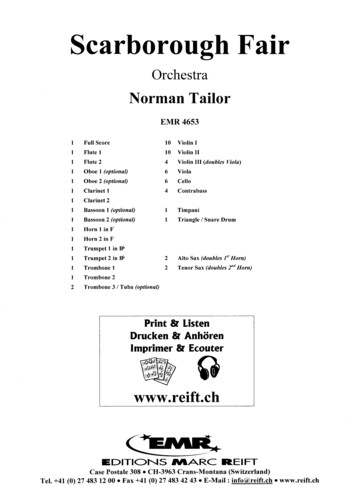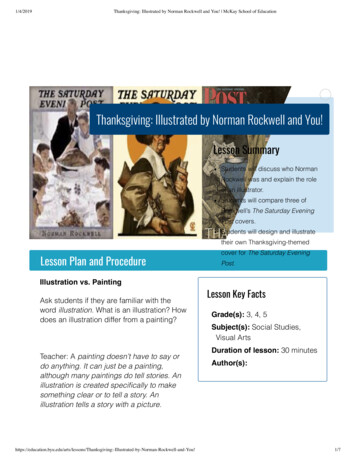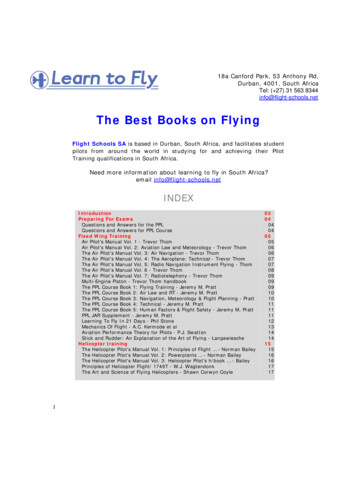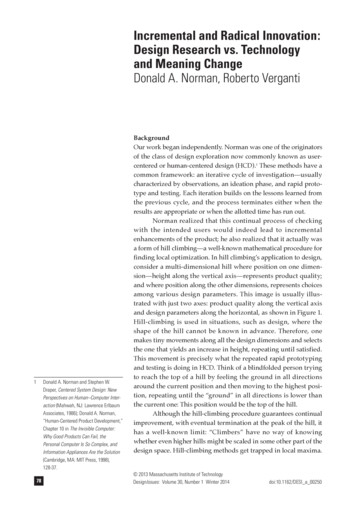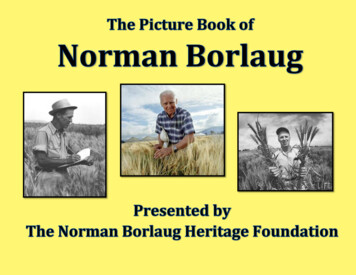
Transcription
Young Norman and his cousin VilmarNorman’s Humble Beginning:Norman Borlaug was born on March 25, 1914, 14 milessouthwest of Cresco, Iowa, to his parents, Henry and ClaraBorlaug.
Norman with his two sisters and parents.Family:Norman was the oldest of three children and had twoyounger sisters, Palma and Charlotte. Norman’sNorwegian family lived with his father’s parents Nelsand Emma Borlaug until he was seven years old.
The Borlaug family had a subsistence farm. Their familygrew a garden, milked cows, raised chickens and hogs, andwent hunting and trapping for food.
“Fill your head now to fill your belly later” – Grandpa NelsThe Borlaug children walked a mile and a half to attend aone-room schoolhouse. One winter Norman walked toschool everyday without a winter coat. The school hadmultiple grades all in the same class, and students had todo chores such as bring wood in for the stove and waterin from the creek. The toilet was in a separate buildingcalled the outhouse.
It was not common for youth to attend high school orcollege, but Norman was encouraged by his family andfriends to continue his education after the eighth grade.He attended Cresco High School and later the Universityof Minnesota.
Norman played many sports growing up. He lovedwrestling, football, and baseball. His dream was tosomeday play second base for the Chicago Cubs. Whileliving in Mexico, he introduced little league baseball tothe community.
Norman met his wife, Margaret, at the University ofMinnesota. They were married in September of 1937.Norman and Margaret were blessed with two children,Norma Jean and Bill.
Cities in red are whereNorman completed his researchResearch on Wheat in Mexico:What is Wheat?Wheat is a cereal plant that is used to make flour forbread, pasta, and pastries.He improved the genetics of wheat to produce moregrain and be disease resistant.
Norman wanted to find a way to fight starvationand his research was the way. They called thisperiod of time the Green Revolution.1 out of 9 worldwide are starving(Binnie,2014)
Each person represents 2 million people (2,000,000) Norman Borlaug’s research saved a billion people & counting from starvation.
Honors:Nobel Peace Prize (1970)Presidential Medal of Freedom (1977)Congressional Gold Medal of Honor (2007)One of seven to receive these three awards; the other sixare Nelson Mandela, Elie Wiesel, Mother Theresa, MartinLuther King Jr, Muhammad Yunus, and Aung San Suu Kyi.
What is the Norman Borlaug Heritage Foundation?The Norman Borlaug Heritage Foundation is a non-profit corporation withan all-volunteer board. The board is dedicated to the restoration andpreservation of the Birthplace farm, Boyhood home and farm, andschoolhouse of Dr. Norman E. Borlaug. These facilities are used toeducate visitors, the community, and youth in order to inspire them tofollow in Norman’s footsteps.GoalThe Foundation’s immediate goals are centered around funding anendowment for restoration and upkeep of Dr. Borlaug’s Birthplace andBoyhood home and schoolhouse,, and the continuation of the BorlaugEducation and Outreach Program. Education was extremely important toDr. Borlaug, and much of the work carried on by the Foundation centersaround education.ContactIf you wish to visit his home farm and schoolhouse, please contact us atnbhf@normanborlaug.org or write to NBHF, PO Box 403, Cresco, IA 52136
How can you fight HUNGER like Norman?1. Find ways to put surplus food to better use.Project Ideas: Organize a gathering event – collect and donate extra food. Or,help connect sources of extra food with food banks or community kitchens.2. Organize food drives or fundraisers.Project Ideas: Organize a competition between classes, schools, sportsteams, or churches to see who can collect the most food, money, or coupons.Focus on collecting healthy food as well as multicultural food that families inyour neighborhood will want to eat. You can also clip coupons to help hungryfamilies stretch their limited grocery budget.3. Plant or spruce up a school or community garden.Project Ideas: Create a garden at your school or in your neighborhood. Youcould also help families’ plant individual gardens (or container gardens forthose without yards).
4. Volunteer at a local food bank, pantry, shelter, or communitykitchen.Project Ideas: Get a group of friends, classmates, or neighbors to volunteer.While food banks and pantries need volunteers every day of the year, thinkabout doing more than the “usual” volunteer jobs. Ask the food bank or pantry ifyou could bring extra volunteers for one day in order to accomplish more at atime of need. Or, set up an ongoing volunteer program, and get other kids tosign up to volunteer over the summer.5. Start or support a backpack feeding program.Project Idea: Start a backpack feeding program at your school. Work withadministrators at your school to get teachers on board, let families know aboutthe program, gather supplies, collect food, and set up the program.6. Support and raise awareness of summer feeding programs.Project Ideas: Find a community organization where kids spend time duringthe summer, like a community center, summer camps, or parks. Then, invitethe organization to be a program sponsor or feeding site. Once your site isestablished, help spread the word to let eligible families know about thesummer feeding sites, or help plan fun and educational activities that bring kidsto sites.
7. Increase use of SNAP (formerly called food stamps) and/orFree and Reduced-Price School Meals programs.Project Ideas: Figure out how you can help get more kids who are signed upto eat meals at school instead of skipping meals – especially breakfast.Contact your principal to learn more about how your school lets parents knowabout free and reduced- price school meals, and ask them how you can helpget more eligible families signed up. Or, contact your local SNAP office to geta copy of the SNAP sign up form to distribute, or organize a community eventwhere people can come and learn about the program and sign-up.8. Help teach families about healthy eating and cooking.Project Ideas: Organize a class at a food pantry, shelter, community center,or school to teach kids and parents how to prepare healthy food on abudget.
9. Raise public awareness of childhood hunger in yourcommunity.Project Ideas: Host an assembly at your school and/or service fair wherelocal nonprofits can share what they do and get students to sign up tovolunteer. Create a social media campaign to share facts about childhoodhunger and how people can help. Organize a youth essay, video, or artcontest focused on the issue of childhood hunger. Film a public serviceannouncement that can be played at your school and shared online. Paint amural or create another piece of public art to highlight the issue of hunger.10.Advocate for policies and programs that will help endchildhood hunger in your community.Project Ideas: Conduct an assessment or mapping of hunger in yourcommunity, and organize an advocacy campaign to contact your localelected officials. (Send a letter to the editor, meet with local electedofficials, invite them to a service project, or get groups of people to e-mailand call Congress to help protect SNAP.)(Youth Service America, 2014)For more information about programs to help fight hunger, please visit thewebsite below:http://www.ysa.org/10wayhunger
Copyright2015NormanBorlaugHeritageFoundation
“Fill your head now to fill your belly later” The Borlaug children walked a mile and a half to attend a one-room schoolhouse. One winter Norman walked to school everyday without a winter coat. The school had multiple grades all in the same class, and students had to do chores such as
